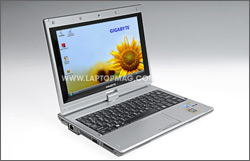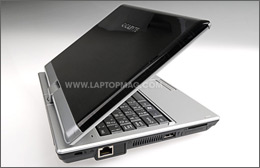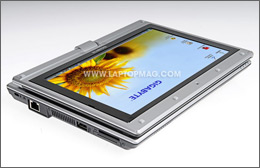Laptop Mag Verdict
This mini-notebook's swiveling touchscreen turns heads, but a few weaknesses diminish its appeal.
Pros
- +
Responsive touchscreen
- +
Stylish glossy lid
- +
ExpressCard slot
- +
Good productivity punch
Cons
- -
Poor battery life
- -
Cramped keyboard
- -
No dedicated screen-orientation button
- -
No preloaded touch software
Why you can trust Laptop Mag
Software and Extra Features

Click to enlarge
Our Gigabyte M912V came preinstalled with Windows Vista Home Basic. While Gigabyte bundles the system with a 90-day trial of Norton Security Suite, it skimps on productivity software. It does, however, provide the Main Menu program, which, in addition to changing the screen orientation, contains large shortcuts to applications such as Internet Explorer or Vista's Network Connection manager.
Verdict
The Gigabyte M912V has the potential to shake up the mini-notebook market, but it hasn't mastered the basics of comparable systems. While the touch experience is solid and as good as many of the other tablets out there, its limited endurance, cramped keyboard, and hot temperature limit its potential. It packs much of the tablet functionality of the Fujitsu LifeBook P1620, which is the same size but costs $1,400 more, but the P1620 offers twice the performance and battery life. If you're looking primarily for a mini-notebook that lets you use your finger to navigate the Web, the $699 M912V is the best choice. But if you want a cheaper 8.9-inch netbook to tote around on the go, the $379 Acer Aspire one or the $599 Eee PC 901 will do the trick.
Solid Performance

Click to enlarge
The Gigabyte M912V's 1.6-GHz Intel Atom processor and 1GB of RAM provided good performance, especially considering it's running Microsoft's Windows Vista Home Basic rather than the slimmed-down Windows XP. While it took Vista Home Basic a glacial 1 minute and 31 seconds to start when it was running the preloaded Norton AntiVirus, we cut the boot time down to about 55 seconds once we removed the software. That's still longer than XP-based mini-notebooks require but tolerable.
In our hands-on experience, the Gigabyte M912V was snappy. Firefox 3 and Windows Media Player opened quickly, and simultaneously conducting video calls over Skype, surfing the Web, and streaming music caused no noticeable performance hit.
On PCMark Vantage, which measures Vista application performance, the mini-tablet notched 1,076, which is low for any notebook, but it handled Microsoft Word and Excel 2007 while running a hard drive test with only a few delays--not enough to deter us from using it. The integrated graphics scored 598 on 3DMark03, which is only 8 points lower than the MSI Wind NB's 606, the highest a netbook has scored on that test (and it managed 746 overclocked). The system can't handle 3D gaming in general, but when we watched Anchorman via an external DVD drive, playback was smooth.
The M912V's 160GB 5,400-rpm hard drive returned respectable read rates of 54.2 and 46.7 MBps on HD Tach and Sisoft Sandra (both of which measure hard drive speed) while maintaining an 18ms seek time on both benchmarks.
On our file copy test, which tests the speed of transferring 5GB of mixed media files from one folder to another on the hard drive, the transfer took 4 minutes and 4 seconds, or 21 MBps. That was 4 minutes faster than the MSI Wind which took 8 minutes and 32 seconds to transfer the same set of files. When copying the files from an external drive to the hard drive, the transfer moved at a slower 11.3 MBps.
One Hot Chassis
Though we didn't find any performance hang-ups while conducting our day-to-day computing activities on the M912V, we noticed that the entire system got uncomfortably hot when we used the notebook at length. In regular laptop mode, the keyboard felt like it had a fever, with an unpleasant temperature of 96.5 degrees. The bottom of the system and the touchpad were a little cooler, at 92 degrees for both.
When we rotated the screen to tablet mode, things really started cooking. Placing the back of the lid against the keyboard increased the temperature between the G and H keys to a whopping 106 degrees. And it started to feel a burn when we held it in the crook of our arm for more than five minutes.
Short Endurance, Decent Wi-Fi
While one of the biggest selling points of the Atom processor has been the ability to provide lots of endurance, the M912V's four-cell battery provided us with subpar results. It lasted 2 hours and 31 minutes on our browsing test, whereas other Atom-based mini-notebooks (albeit with six-cell batteries) lasted twice as long. Unfortunately, Gigabyte does not yet offer a higher-capacity battery.
Sporting an 802.11b/g Wi-Fi radio, the M912V provided a strong connection for working in the cloud. Data zipped at a rate of 16.8 Mbps 15 feet away from our access point and 10.6 Mbps at 50 feet. While those scores are better than average, our connection dropped sporadically. The Bluetooth 2.1 connection will come in handy for transferring photos and other files from your cell phone to the M912V.
Washed Out, High-Resolution Screen
As with other tablets, the M912V's matte, 8.9-inch, 1280 x 768-pixel resolution screen is relatively dull; adjusting the brightness to 100 percent still left colors muted. In a side-by-side comparison with theFujitsu LifeBook P1620, a convertible also sporting a 8.9-inch screen, the P1620 was clearly brighter and offered more contrast. Then again, you'll pay about $2,100 for the Fujitsu.
While horizontal viewing angles were decent, we saw a noticeable glare when the M912V's screen is tilted back; when we watched a YouTube clip, too much light reflected back with the screen at a 45-degree angle. Compared with the typical 1024 x 600-pixel resolution you'll get with other 8.9-inch systems, we appreciated the higher pixel count of the M912V, which allowed windows to fit correctly on the screen. However, users with weak eyes may find text and icons too small.
The 180-degree rotating hinge that turns the screen into tablet mode felt very sturdy. The screen didn't wobble in either the normal laptop mode or in the tablet position, clipped down to the keyboard.
Tablet Performance

Click to enlarge
The M912V's standout feature is its resistive touchscreen, which supports both stylus and finger input. A stylus pen is tucked into the top of the screen, but we preferred using our fingers; we had no problem launching programs by just tapping them. Because the Windows Vista Home Basic operating system does not support Microsoft's Tablet PC feature set such as Pen Flicks, we had to install many of our own freeware programs to take full advantage of the touchscreen. After installing Grab and Drag's Firefox add-on, we were able to surf the Web using just our finger; a light swipe let us scroll quickly through long Web pages, and tapping the browser's buttons allowed for easier navigation than on the Fujitsu LifeBook P1620.
Scribbling in Microsoft Paint using the stylus didn't require us to press down too hard, and drawing and writing was smooth. However, we noticed our palm inadvertently painting for us as well. Because the screen has no active digitizer, it doesn't distinguish from hovering.
When we opted to change the screen orientation to portrait mode, we were disappointed to find that the M912V lacks a button to rotate the screen. Instead Gigabyte provides a Main Menu application, which launches large on-screen icons, including one for rotating the screen. Unfortunately you have to dig for the menu in the taskbar every time you want to change the orientation.
If you've seen one mini-notebook, you might think you've seen them all--that is, until you lay eyes on the Gigabyte M912V. Taiwanese electronics manufacturer Gigabyte, most known for making motherboards, has introduced this hybrid tablet to make some waves in what's becoming a flooded mini-notebook market. The stylish M912V sports a unique 8.9-inch, swiveling touchscreen and is powered by a 1.6-GHz Intel Atom processor and 1GB of RAM. For $699 the touch and tablet experience are good for the price; however, this system suffers from poor battery life, uncomfortably hot temperatures, and a cramped keyboard. Gigabyte says the M912V may not come to the U.S. at all, but even if you can get your hands on one, we would buy with caution.
Snazzy Lid, Comparably Larger Footprint
The Gigabyte M912V's glossy black lid, complete with a modern silver-square inlay pattern, looks like a kind of sci-fi circuit board and is fetching both up close and from afar. Unlike the black shiny lid on the Eee PC 1000H, the silver imprint hides fingerprints well. Measuring 9.2 x 7.1 x 1.1-1.7 inches, the system is nearly an inch thicker than the 10-inch MSI Wind; and at 3 pounds, it's 6.4 ounces heavier than the Eee PC 901. Nonetheless, the M912V slid nicely into a backpack and didn't weigh us down. Gigabyte has also kept the power brick slim, bringing the total travel weight to a manageable 3.4 pounds.
Cramped Keyboard, Smooth Touchpad
In a market where recent mini-notebooks have keyboards friendly to touch typists (we're particularly fond of those on theAcer Aspire oneand theHP 2133 Mini-Note), the Gigabyte M912V takes a step back. The keyboard has a nearly identical look and feel to that of the original Eee PC 701 or theEverex CloudBook. Our hands felt cramped and we frequently made typos. Nevertheless, the keys provided decent feedback with little flex.
The touchpad has a metallic surface that matches the M912V's wrist rest, and it offered a nice textured feel as we navigated around the desktop. Unlike the rock-hard buttons on theEee PC 1000and 901, the two mouse buttons, located below the touchpad, were easy to click.
Good Port Selection, Solid Speakers

Click to enlarge

Click to enlarge
The M912V's slightly larger size pays off in ports. The system manages to fit three USB ports, as well as VGA, Ethernet, microphone, and headphone ports. It also has a 3-in-1 memory card reader and a ExpressCard/34 slot, which was perfect for popping in a mobile broadband card.
The integrated 1.3-megapixel webcam worked when we initiated a video chat over Skype, but our face looked washed out, and our caller complained of motion blur as we moved our hands. The microphone, located above the keyboard, provided decent audio to our caller; he could hear us well without us having to speak up. The speakers, placed right under the keyboard, delivered strong and solid sound. Streaming music over Slacker played loud enough to fill a small living room.
Gigabyte M912V Specs
| Bluetooth | Bluetooth 2.1+EDR |
| Brand | Gigabyte |
| CPU | 1.6-GHz Intel Atom |
| Card Slots | 3-1 card reader, ExpressCard |
| Company Website | http://www.gigabyte.us |
| Display Size | 8.9 |
| Graphics Card | Mobile Intel 945GSE |
| Hard Drive Size | 160GB |
| Hard Drive Speed | 5,400rpm |
| Hard Drive Type | SATA Hard Drive |
| Native Resolution | 1280x768 |
| Operating System | MS Windows Vista Basic |
| Ports (excluding USB) | VGA, Microphone, Headphone, Ethernet |
| RAM | 1GB |
| RAM Upgradable to | 2GB |
| Size | 9.2 x 7.1 x 1.7 inches |
| USB Ports | 3 |
| Video Memory | 64MB |
| Weight | 3.0 pounds |
| Wi-Fi | 802.11b/g |
